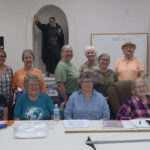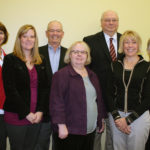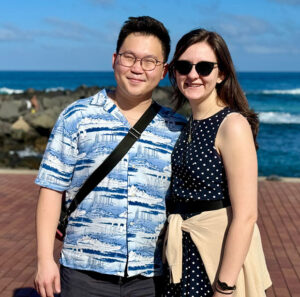
Lisa and Eugene Ryoo of St. Patrick Parish in Iowa City.
By Barb Arland-Fye
The Catholic Messenger
Iowa City — Lisa and Eugene Ryoo, who are approaching their second wedding anniversary, treated themselves to a couples’ prayer enrichment experience because “we felt we hadn’t ‘hit our stride’ with praying together,” Lisa said. The doctoral students, members of St. Patrick Parish in Iowa City, were among couples spanning the range of the sacramental marriage journey participating in “Let’s Pray Together,” a diocesan event held Feb. 25 in St. Patrick Parish Hall.
“Many of us are comfortable praying individually and according to the ways we are most comfortable. But we might not know how to pray together or where to start,” said Ella Johnson, associate professor of theology at St. Ambrose University in Davenport, who led the couples’ prayer experience. “There hasn’t been a lot of focus on married spirituality in the past as much as there has been (on Christian spirituality) with those who are ordained or religious.”
Johnson introduced the couples to four temperaments of prayer: path of intellect (Thomistic prayer); path of devotion (Augustinian prayer); path of service (Franciscan prayer) and path of asceticism (Ignatian prayer). Thomistic prayer is “characterized by orderly progress of thought from cause to effect.” These prayer types may study a virtue, habit or truth from every angle. Augustinian prayer “uses creative imagination to transpose the world of Scripture to one’s situation today.” These prayer types may prefer Lectio Divina, a reflective form of prayer using Scripture. Franciscan prayer “is not tied down by rules, but open to following the inner spirit.” Examples include Gospel stories about Jesus; meditating on God’s creation. These prayer types seek acts of loving service. Ignatian prayer “imagines oneself in a biblical scene in order to draw some practical fruit for today.” (Source: US Catholic, March 1996).
Separately, each partner completed a short survey to determine his or her spiritual pathway and then gathered at tables with other participants who share the same spirituality preferences. Afterwards, the participants journaled their responses to questions Johnson posed about their prayer and spiritualty preferences as individuals. Then, reunited with their partners, they shared as couples what they have learned from and about each other.
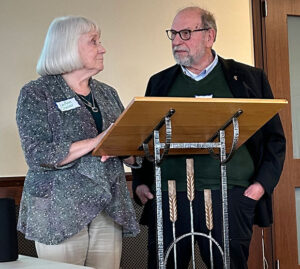
LuAnn and Bob Glaser of West Des Moines (formerly of Burlington).
Prayer is a journey
Deacon Bob and LuAnn Glaser of West Des Moines (formerly of Burlington) shared with the gathering their prayer life journey through their 50 years of marriage. “We grew from just saying a prayer before meals to praying together before bedtime. Each night we ask each other for forgiveness for any hurts we may have caused the other during the course of the day and acknowledging we are in a state of sacramental marriage,” LuAnn said.
The tradition of asking for forgiveness began after Deacon Bob and LuAnn attended a workshop with Father Rob Ruhnke, founder of For Better & For Ever Marriage Preparation Program. “Father Bob said that if he were a husband he would ask his wife for forgiveness and she would ask him for forgiveness,” Deacon Bob said. “We’re called to be merciful just as God is merciful to us. That’s a practice we’ve followed for more than 40 years.” Sometimes, it is difficult “to let go of the hurts,” LuAnn said. The Glasers hope that their presentation helps the couples “understand that prayer is a journey and that over a lifetime one’s prayer life will grow and take different turns.”
Musicians add to repertoire
Lisa and Eugene approached the presentation hoping to take away how to pray better as a couple. “Eugene and I learned to pray very differently growing up. Eugene is a convert and I am a cradle Catholic,” Lisa said. “Based on our efforts, we were convinced that we favored different types of prayer. We were both completely shocked at the event to learn that we had scored the same category in the quiz to assess prayer types. It turns out the ‘free style’ prayers that we had been trying was not preferred by both of us and that we both strongly prefer structured prayer.”
“Going forward, we’re exploring more structured and written-out prayers: Liturgy of the Hours, Divine Mercy Chaplet and more. We recently did a Consecration to St. Joseph, which was revealing for us to try. Eugene and I are both doctoral students and so we enjoy finding beautifully written and deep materials and prayers about the faith,” Lisa said.
“I think that we will continue to find beautiful prayers that are new to us. I think it’s helpful for couples to be reminded to keep exploring and practicing different types of prayer, being aware of what the other (partner) feels more comfortable with and that things can change. As musicians, Eugene and I are very accustomed to practicing repertoire carefully and thoroughly. It now makes sense to us that our preferred prayer types are the same, and yet we accept that they could very well evolve in the future.”
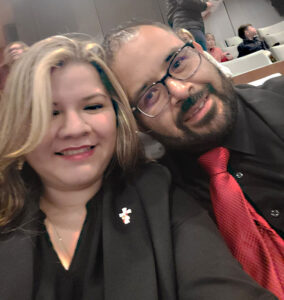
Lourdes and Deacon Angel Hernandez of St. Patrick Parish in Iowa City.
Lectio Divina: a great gift
Lourdes Hernandez, who attended the event with her husband, Deacon Angel Hernandez, said she was looking forward to hearing about “the different ways a couple can pray together. How that would enrich our lives and help us remain united through prayer. I really enjoyed learning about the different types of prayer. How they can help enrich different aspects of our daily lives, from the big, life-changing event to the everyday routines.”
She and her husband, members of St. Patrick Parish in Iowa City and married nearly 11 years, “prayed as a couple more a couple of years back. We used to pray the Liturgy of the Hours together and we would be in silent prayer at exposition. Lately, we have not prayed together as much.” The presentation on Feb. 25 encouraged them to try again. “How this will begin, we have yet to figure out. But we were both very inspired by the information presented and by Deacon Bob and LuAnn’s testimony, they are an inspiration,” Lourdes said.
The last part of the presentation, an exercise on Lectio Divina, resonated with Lourdes. “The time we spent in Lectio as a couple was, for me, very needed… I shared with the group that listening to your spouse’s voice during Lectio was a great gift. Typically, we talk about work, life, etc. but even though we are hearing, we aren’t listening. Lectio allowed us to truly listen to our spouse, have a deeper conversation and find the quiet moment that we don’t usually have. This practice is something we both would like to do more often. It allowed us a moment to be in quiet, listen to the word of God and hear each other out.”
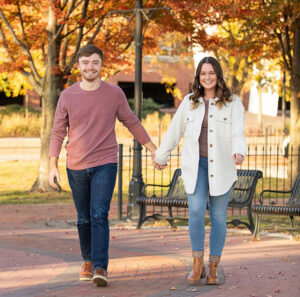
Johnny and Sarah Callahan were married at Christ the King Chapel at St. Ambrose University in Davenport.
A multitude of prayer styles
“I went in with hopes of learning about how other couples incorporate prayer in their relationships, and we got that and more,” said Johnny Callahan, who participated in the event with his wife, Sarah Callahan. “We learned how our different spiritual temperaments impact what types of prayer we each get the most out of,” added Johnny. He and Sarah were married July 22, 2023 in Christ the King Chapel at St. Ambrose University in Davenport.
“I think it is easy to slide into the routine of just praying before meals and in times where loved ones ask for specific, urgent prayers,” Sarah said. “After having this experience, we feel that we have a multitude of prayer styles to try together — Lectio Divina, praying with our 5 senses, putting ourselves into the Gospel stories, the Ignatian Examen, etc.”
“In our personal lives, we both enjoy praying through journaling. Together, we like to go on walks to discuss what has been in each of our prayers, although, we don’t do this as much as we’d like to!” Johnny said. “This experience inspired us to be more intentional in our prayer life together.”
The Glasers, whose favorite form of prayer is Liturgy of the Hours, believe they can “always seek to improve our prayer life and that can be done by listening to others’ experiences and being open to new ideas. We believe our prayer life should not be stagnant,” LuAnn said. “We did not know that we each have a spiritual pathway and learned about ourselves from the spiritual pathway survey that Ella had us complete. We plan to implement suggestions associated with each spiritual pathway in our prayer life.”
Ella hopes the presentation gave couples “some time to have important conversations together about prayer and their relationship. I hope it gave them a chance to learn more about the different ways they follow the Great Commandment to love God, self and others and perhaps the ways they might do this together. It was lovely to watch couples chatting and praying together!”










